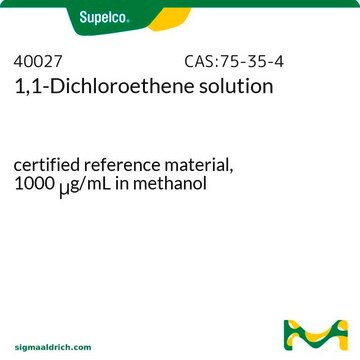163023
1,1-Dichloroethylene
contains 200 ppm MEHQ as inhibitor, 99%
Sinónimos:
Vinylidene chloride
About This Item
Productos recomendados
vapor density
3.46 (vs air)
vapor pressure
9.68 psi ( 20 °C)
assay
99%
form
liquid
autoignition temp.
968 °F
contains
200 ppm MEHQ as inhibitor
expl. lim.
15.5 %
bp
30-32 °C (lit.)
mp
−122 °C (lit.)
density
1.213 g/mL at 20 °C (lit.)
storage temp.
2-8°C
SMILES string
ClC(Cl)=C
InChI
1S/C2H2Cl2/c1-2(3)4/h1H2
InChI key
LGXVIGDEPROXKC-UHFFFAOYSA-N
¿Está buscando productos similares? Visita Guía de comparación de productos
Application
signalword
Danger
Hazard Classifications
Acute Tox. 3 Oral - Acute Tox. 4 Inhalation - Carc. 2 - Eye Irrit. 2 - Flam. Liq. 1 - Skin Irrit. 2
Storage Class
3 - Flammable liquids
wgk_germany
WGK 3
flash_point_f
-2.2 °F
flash_point_c
-19 °C
ppe
Eyeshields, Faceshields, Gloves
Elija entre una de las versiones más recientes:
¿Ya tiene este producto?
Encuentre la documentación para los productos que ha comprado recientemente en la Biblioteca de documentos.
Los clientes también vieron
Nuestro equipo de científicos tiene experiencia en todas las áreas de investigación: Ciencias de la vida, Ciencia de los materiales, Síntesis química, Cromatografía, Analítica y muchas otras.
Póngase en contacto con el Servicio técnico












